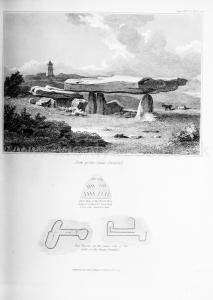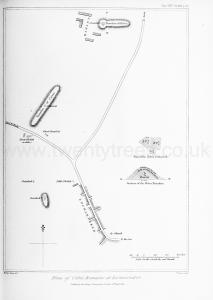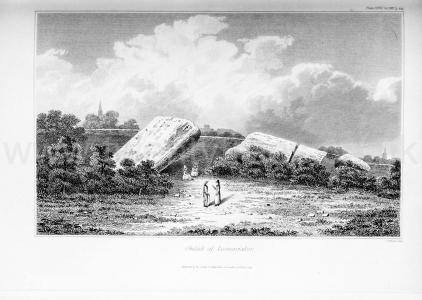Archaeologia Volume 25 Section XIII
Archaeologia Volume 25 Section XIII is in Archaeologia Volume 25.
Remarks on certain Celtic Monuments at Locmariaker, in Britany; in a Letter from the Rev. John Bathurst Deane (age 36), M.A., F.S.A., to Henry Ellis, Esq. F.R.S., Secretary. Read 17th January, 1833.

London, January 17, 1833.
My Dear Sir,
The accompanying plan of the village of Locmariaker and its vicinity is necessary to the completion of my description of the Dracontium of Carnac, lately read to the Society of Antiquaries; and I shall be obliged if you will lay it, together with the following remarks, before the Society.
In my late communication I expressed an opinion that the Temple of Carnac originally extended as far as the present Locmariaker; and I conceive that my conjecture is much corroborated by the beautiful Celtic monuments remaining in that vicinity. Locmariaker is by some supposed to have been the ancient capital of the Veneti before the seat of Government was removed to Vannes. But this is not probable, from considerations too numerous to recite, and too irrelevant to my subject. Locmariaker was, however, without doubt, a great town, and the capital of the district in which it stood. For here is to be seen a group of some of the most interesting Celtic remains in the Morbihan.
The accompanying plan (Plate XXV.) exhibits within a small area two long tumuli, each containing a Kistvaen; a small tumulus with a Kistvaen of unusual length; two cromlechs, one of them of singular beauty; and two obelisks, each carved out of a single stone, of which one measured upwards of 35 feet in length, the other 63!
1. The tumuli are clearly sepulchral from the evidence of the Kistvaens which they once covered. The two largest are called the mounds of Héleu, and of Cæsar. The small one is nameless, although it contains the longest Kistvaen.
The tumulus of Héleu [Mané Lud Burial Mound [Map]] is 100 feet broad, 300 feet long, and has an elevation of 30 feet. That of Cmsar is of the same elevation and breadth, but 400 feet in length. They are both composed of layers of earth and stones, separate and mixed. The section of Heleu given in the plan shows 26 feet of earth, overlaid by a coating three feet deep of earth and stones, surmounted by a covering of earth one foot in depth.
This tumulus is remarkable for its shape, which is very similar to that of the Temple of Carnac at Le Maenac; a campanular [bell shaped] head being added to the usual straight mound of parallel sides.
In this head is a Kistvaen of considerable dimensions; and particularly interesting, as being partly exposed and partly covered. It affords an example of the manner in which the Kistvaens were overlaid by tumuli. Two tabular stones cover the chamber. One is a parallelogram fifteen feet six inches by fourteen feet; the other, an irregular quadrangular figure with an acute angle pointed towards the entrance of the tomb. Its breadth at the base, where it meets the parallelogram, is fourteen feet nine inches; its breadth from the angle to the base, thirteen feet. The dolmen is supported in the usual manner upon massive props. The whole length of the Kistvaen is twenty-seven feet, the depth of the chamber six feet.
The other long tumulus, which has its Kistvaen in the centre, is ridiculously ascribed to Julius Caesar, whose only work (if it was indeed his) in the neighbourhood of Locmariaker, is a curious square embankment on the sea shore about a mile distant, round a marine marsh, appearing to have been made for the purpose of a dry dock. General de Penhouet, who discovered it, thinks it Roman; and it has every appearance of being so. The tumulus ef Caesar has been much disturbed, and its Kistvaen destroyed.

2. But near it is the most beautiful cromlech [Table des Marchands [Map]] which I have ever seen; and I may add, the most interesting. The table stone, which is eighteen feet long, twelve feet wide, and four feet thick, is supported upon three props, on one of which it rests upon a very small point. It has the approach usually attached to the Kistvaens of Britany, consisting of an avenue of contiguous stones placed edge to edge, and covered in by three slabs of stones. The highest part of the table is about nine feet from the ground, the height of the approach is about four feet.
Although this monument is, strictly speaking, a cromlech, yet the ashes and a flint knife which have been discovered under it, together with the avenue of approach, prove it to have been sepulchral.
The beauty of this cromlech would of itself be sufficiently interesting; but, in addition to its elegance of figure, it presented to our admiration the only hieroglyphical characters which it was our fortune to see inscribed on a Celtic monument; unless I except a rude unmeaning or rather unintelligible scrawl upon one of the supporting stones of the Dolmen of Penab, which bears more resemblance to the human ear than to any other figure.
The extreme supporter of the table stone of the Cromlech of "Caesar" is -charged with remarkable curvilinear characters, regularly arranged in two columns, each containing three divisions of four lines each. Great care has been bestowed upon their execution, for they are not cut into the stone, but raised upon it. I cannot conceive what they were intended to represent.
The table also exhibits upon its under surface two hieroglyphical diagrams, similarly raised upon the stone, whose execution is admirable, though one of them is imperfect, from the pealing of the stone by frost.
I confess myself ignorant of the meaning of these hieroglyphics also, and leave their interpretation to more experienced antiquaries. One of them resembles, in some degree, the instrument called a Celt; the other is more like a key. But M. Mahé, who seems to have seen only the former (which was my case on my first visit, for the latter is more obscurely traced), called it an [Greek Text]. The conjecture is plausible, if the worship of the Phallus can be clearly proved against the Armoricans. That Asiatic and Egyptian ideas had, by some means or other penetrated into this country, is probable from several facts insisted on by M. de Penhouet. Thus, there is an artificially carved rock in the Morbihan which very closely resembles the god Anubis. Again, the Syrian deity Lilith, so celebrated in the mythology of the Jewish Rabbins, was once adored in the Morbihan. Her statue may be still seen in a perfect state at the chateau of Quinipili, near Baud, where it was placed upon a pedestal by a former owner of the domain. The only covering which the figure has is a cap with two flaps; and what is very remarkable, the head-dress of the female peasantry of the commune in which the statue stands, is precisely a copy of Lilith's cap, and worn in the same manner! For how many centuries that head-gear has been worn it is in vain to guess. Another peculiarity of dress, which savours of an oriental origin, is observable among the male peasants: they all wear a checked cloth, like the South-country plaid of Scotland, bound round the loins, and call it a "turban." My friend M. de Penhouet conjectures that, when the Asiatic colony (whoever they were) emigrated to Britany, they transferred the turban from the head to the loins, retaining the name, though they lost the original use of the garment. Still, however, I do not see sufficient evidence of the worship of the Phallus in Armorica, which must have prevailed, if the hieroglyphic on the cromlech is a representation of the [Greek Text].
Within another tomb at Locmariaker (now I believe destroyed), M. de Penhouet discovered, in 1813, several very interesting hieroglyphics, which he has engraved in his "Archeologie Armoricaine." The circle (single and concentric), the horseshoe, the branch of a tree, and the harp, are the symbols chiefly delineated. The first three are sometimes seen in conjunction with the horse and horse's head upon the coins of Armorica.

3. The third species of monument remaining at Locmariaker is the round Obelisk [Menhir Er Grah [Map]]. A beautiful one stood at the head of Caesar's tumulus; and it was sixty-three feet in length and fourteen feet in diameter at the thickest part, which is at about twenty feet from the base. From this point it tapers gradually both ways. Another obelisk, about thirty-five feet in length, lies at the entrance of the village; its tumulus was perhaps removed to make room for a house. Each of these is cut out of a single stone.
These obelisks probably denoted the burial-places of warriors of the first rank: and may have originated in the well-known custom still prevalent in the East, of planting an upright spear at the head of a Chief as he slept upon the ground. It was thus that David found Saul on the hill of Hachilah: "Behold Saul lay sleeping within the trench, and his spear stuck in the ground at his bolster."a This custom was universal in the East. Homer mentions it, and it has been repeatedly observed by travellers in Persia and Hindustan. The spear at the head, thus planted, always denotes a warrior of the highest rank.
Some mighty Celtic chief may in like manner be supposed to be sleeping at Locmariaker, under the tumulus of Caesar, "with his spear stuck in the ground at his bolster: "only the sleep being that of death, the spear is of a material of corresponding duration; it is an obelisk of stone cut out of a single block.
The evangelizers of Britany, for they probably were the destroyers, suffered not the warrior's spear to mark his last resting-place. The obelisk was overthrown, as an object of superstitious veneration, and now lies broken in four pieces. The tomb also has been rifled of its sacred deposit; and the whole is but a variety of the continual work of ruin which in every country records the mutability of man, and the vanity of his earthly hopes.
The original weight of this column must have been about 260 tons! and the labour required to remove it from the quarry and to plant it at the head of the tumulus of Caesar may be imagined, by calling to our recollection the power employed by Fontana to place the obelisk of the Vatican in its present site at Rome. The latter column was only fifteen feet longer than the obelisk before us; and, although it weighed only 150 tons, whereas that of Locmariaker weighed 26 0, yet it required the united efforts of eight hundred men and sixty horses, complex machinery, and the expenditure of ^*5000, to remove it for a short distance, and erect it as it now stands! We should also recollect that the erection of the obelisk of Locmariaker was the work of a rude age, ignorant, probably, of the mechanical powers, and mainly effected by human strength.
Note a. 1 Samuel, xxvi. 7.

Such are the monuments in the immediate vicinity of Locmariaker; but the commune is covered with many vestiges of the religious and powerful people who once worshipped in the Dracontium of Carnac. From the number and nature of these Celtic remains, I cannot but think it probable that the Temple of Carnac extended to Locmariaker, the ancient capital of the district. This opinion may be erroneous; but the indications are strong.
With these remarks I conclude my observations on the Antiquities of the Morbihan; and remain, with great respect,
My dear Sir,
yours sincerely,
John Bathurst Deane.